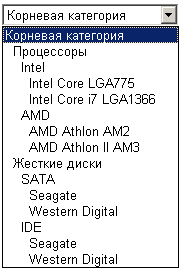たとえば、構造は次のXMLで表現されます。
注: 実際には、属性に文字列を保存するのはよくありません;それらを別々のノードにして、CDATAでラップする必要があります。 ただし、ここでのタイトルは、スペースを節約するための属性です。 したがって、悪い例を挙げないでください。< categories >
< category id ="1" title ="" >
< categories >
< category id ="2" title ="Intel" >
< categories >
< category id ="3" title ="Intel Core LGA775" >
< categories />
</ category >
< category id ="4" title ="Intel Core i7 LGA1366" >
< categories />
</ category >
</ categories >
</ category >
< category id ="6" title ="AMD" >
< categories >
< category id ="6" title ="AMD Athlon AM2" >
< categories />
</ category >
< category id ="7" title ="AMD Athlon II AM3" >
< categories />
</ category >
</ categories >
</ category >
</ categories >
</ category >
< category id ="8" title =" " >
< categories >
< category id ="9" title ="SATA" >
< categories >
< category id ="10" title ="Seagate" >
< categories />
</ category >
< category id ="11" title ="Western Digital" >
< categories />
</ category >
</ categories >
</ category >
< category id ="12" title ="IDE" >
< categories >
< category id ="13" title ="Seagate" >
< categories />
</ category >
< category id ="14" title ="Western Digital" >
< categories />
</ category >
</ categories >
</ category >
</ categories >
</ category >
</ categories >
* This source code was highlighted with Source Code Highlighter .
そのため、このXMLからドロップダウンリストを作成する必要があります。 これを行う最も簡単な方法は、次の変換を記述することです。
< xsl:stylesheet version ="1.0" xmlns:xsl ="http://www.w3.org/1999/XSL/Transform" >
< xsl:output method ="html" indent ="yes" />
< xsl:template match ="categories" >
< select >
< option value ="0" > </ option >
< xsl:apply-templates select ="//category" />
</ select >
</ xsl:template >
< xsl:template match ="category" >
< option value ="{@id}" >
< xsl:value-of select ="@title" />
</ option >
</ xsl:template >
</ xsl:stylesheet >
* This source code was highlighted with Source Code Highlighter .
その結果、私たちはそのような画像を取得します

一般的には機能しますが、カテゴリツリーをツリーのように見せたいです。 また、ここで
select
いるので、適切な場所にスペースを配置することによってのみこのツリーを取得できます。 もちろん
optgroup
がありますが、この場合、カテゴリは任意に大きなネストを持つことができるため、私たちを救うことはできません。
解決策
ここで、そのような自転車は与えられた問題を解決します:
< xsl:stylesheet version = "1.0" xmlns:xsl = "http://www.w3.org/1999/XSL/Transform" >/>
< xsl:出力 メソッド = "html" インデント = "yes" />
< xsl:テンプレート 一致 = "/" >
< 選択 >
< オプション 値 = "0" >ルートカテゴリ</ オプション >
< xsl:call-template name = "cat_tree" >
< xsl:with-param name = "space" select = "'&#160;&#160;'"
</ xsl:call-template >
</ 選択 >
</ xsl:テンプレート >
< xsl:テンプレート 名 = "cat_tree" match = "categories" >
< xsl:param name = "space" />
< xsl:for-each select = "categories / category" >
< オプション 値 = "{@ id}" >
< xsl:select-of select = "$ space" />
< xsl:value-of select = "@ title" />
</ オプション >
< xsl:if test = "./ Categories" >
< xsl:call-template name = "cat_tree" >
< xsl:with-param name = "space" select = "concat($ space、'&#160;&#160;') " />
</ xsl:call-template >
</ xsl:if >
</ xsl:for-each >
</ xsl:テンプレート >
</ xsl:スタイルシート >
*このソースコードは、 ソースコードハイライターで強調表示されました。
その結果、次の結果が得られます。
